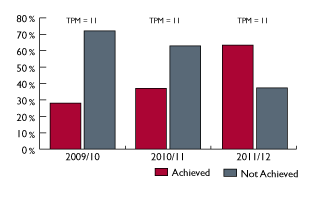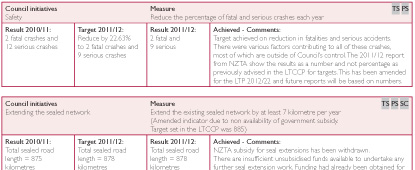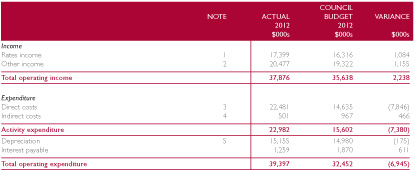At a Glance
Primary Services
Why We Do It
- Council's vision is to provide an effective and sustainable road network that supports community strength and wellbeing; and
- The road network is a vital part of the district that enables safe and comfortable access for employment, personal / social activities and recreation, and the movement of goods and services. The transport network is essential to the functioning of the district's economy, benefiting residents and the district as a whole. Maintaining and improving roads are regarded as 2 of the core functions of Council.
What Has Changed For Roads Since
The LTCCP 2009/19?
There have been significant changes to the roading programme since the publication of the 2009/19 LTCCP. These are primarily due to the changes made after the 2008 General Election to the Government Policy Statement for transport (which now emphasises investment in the Government's nominated roads of national significance) and the economic recession has had a significant impact on housing and property development in the district.
These factors have impacted on Council's ability to carry out capital improvements, such as seal extensions, on the district's road network by severely reducing the amount of funding assistance (or subsidy) available for such work from the New Zealand Transport Agency. Also a shortfall has been created in anticipated development contributions. Additionally, Council has decided to reduce its level of borrowing to fund capital projects.
The most significant results of these changes that are reflected in the Annual Plan are:
The seal extensions that were not funded in 2009/10 that were part funded in 2010/11 subject to 66% of the expenditure being funded from external sources has been deferred. Council has helped several communities to review the potential for sealing local roads based on the understanding that the affected ratepayers will pay the NZTA share with Council meeting the balance of the cost.
Hence the funds allocated for rural seal extensions this year will be used to support Section 4 of Council's Policy No. 4101 Roading. Funding sources whereby Council will enter into appropriate funding arrangements with local property owners where:
- Work is desired ahead of or in addition to the adopted programme;
- 75% of the affected property owners, as determined by a poll, agree with such funding arrangements;
- Already allocated NZTA funding assistance is not used; and
- The Council share is no greater than the local share if NZTA funding assistance for construction work was available. (i.e. Council's share will be limited to no more than 34% of the total cost).
Bridge replacements (Pipiwai W04, Pipiwai W06, Pokapu W19 and Ngapipito Culvert P53) are expected to be finished by July 2013.
Additional land purchases for the Kerikeri CBD alternate route have been deferred. As most submissions to the Draft Annual Plan opposed funding this project by means of a local targeted rate, it is unlikely to proceed any further in the foreseeable future.
Investigations of options for a new road linking Kapiro Road with Waipapa Road, improvements on Hone Heke Road and for a new road linking the Kerikeri south eastern light industrial area with Kerikeri Road have been deferred.
Roads Priorities For 2011/12 |
What We Have / Haven't Achieved |
|---|---|
| Addressing current and future traffic demands | Council has continued to press the NZTA to fund the design and construction phases of the proposed State Highway 10 / Waipapa Road / Waipapa Loop Road intersection upgrade, but the project does still not have approval to proceed. Council funded proposed road link from Klinac Lane to Waipapa Loop Road will not proceed until the State Highway project has the go ahead. |
| Maintenance and renewal | Council has introduced performance managed contracts for the maintenance of the roading assets. The contracts reflect a new roading hierarchy classification system and agreed levels of service or standards that the roads are maintained to. |
| A comprehensive inspection and audit of all bridges on the network has been completed as is being used to establish a forward works programme of maintenance, repairs and replacement of the bridges and structures asset. | Reduces ability to carry out improvements and new projects, including seal extensions. |
| Safety improvements | Council has completed a number of minor safety improvement projects throughout the district, maximising the amount of funding available for the Far North from NZTA. |
| Promoting safer driving | Council has been involved with a number of successful community programmes, to raise awareness and educate communities about high risk issues including drink driving, crashes on bends, speed, child restraint compliancy and fatigue. |
Future Issues / Challenges |
Implications |
|---|---|
| Climate change | Increases exposure to road closures and widespread damage to the road network caused by severe storms. |
| Limited sources of good quality road aggregate | Increases maintenance and construction. |
| Reducing ability to attract NZTA funding assistance, especially for improvements and new works | Reduces ability to carry out improvements and new projects, including seal extensions. |
| NZTA have signalled funding cuts to the local government sector. However, the quantum of the funding cuts is still uncertain | The impact on levels of service is difficult to predict until the funding provisions are released by NZTA but could range from minor to significant dependant on what budget categories are reduced. In order to retain the current level of service, with decreased NZTA funding, will mean that the shortfall will need to be made up from unsubsidised sources. This would mean ratepayers or private road users will pay more. |
| Increasing demands on the road network from heavy vehicles. | Increases maintenance and renewal costs. |
| Large geographic spread of the network, low population density and uneven distribution / expansion of population growth | Decreases affordability of the road network. |
| Lack of data relating to bridge load carrying capacities | Increases exposure to bridge failures. |
| Maintained length of network is based on out of date data | Results in dissatisfaction where roads exist outside of maintained length. |
| Increasing costs (labour, fuel and materials) | Reduces maintenance levels of service and number of improvements and new projects that can be carried out for the same amount of money. |
| Difficulties attracting and retaining appropriately skilled personnel | Reduces the ability to maximise funding assistance and consistently deliver good quality work on time and at the right price. |
| Inspections of all bridges have identified some structures which require more detailed investigation | Level of uncertainty on how much this could potentially cost. |
What Has Changed For Ferry Services
Since The LTCCP 2009/19?
Council undertook an extensive review of the costs and funding of the Hokianga Ferry "Kohu Ra Tuarua," in 2009. As a result of this review, a modest increase was made to some fares to reduce the operating losses. A further increase to some fares was made late last year to cover the increase to GST.
Negotiations have also been held with the NZTA to confirm the amount of subsidy paid to Council to help offset the shortfall of income from fares over costs. The result of these negotiations is that the subsidy now covers 56% of the actual net operating cost (the operating cost less the income received from fares) with the balance of 44% being funded from the general rate.
NZTA has also agreed to subsidise the renewal cost of the ferry when the present vessel reaches the end of its economic life (estimated to be in 2029). An underwater dive inspection carried out last year indicated that the underwater hull of the ferry is in very good condition and hence the 5 yearly haul out for under water hull maintenance that fell due in 2010 was deferred for a year.
Ferry Priorities For 2011/12 |
What We Have / Haven't Achieved |
|---|---|
| Continuing to operate the Ferry “Kohu Ra Tuarua” 7 days a week, 52 weeks of the year and reviewing fares to reduce operating losses and to meet unavoidable cost increases | The priority was achieved and the ferry continued to operate 7 days a week, for 52 weeks of the year. |
| Hauling “Kohu Ra Tuarua” on to the slip way at The Narrows for under water hull maintenance, subject to the outcome of a further underwater dive inspection | The inspection of the hull has been completed and the condition appraisal results indicate that the ship needs to be slipped in the 2012/13 financial year, for necessary overhaul and repair works. |
| Reviewing fares to reduce operating losses and to meet unavoidable cost increases | Council made fare adjustments to minimise the impact on local users and provided additional categories for low frequency travellers who live in the district. |
| Reviewing fares to reduce operating losses and to meet unavoidable cost increases | Council made fare adjustments to minimise the impact on local users and provided additional categories for low frequency travellers who live in the district. |
| Safety improvements | Council has completed a number of minor safety improvement projects throughout the district, maximising the amount of funding available for the Far North from NZTA. |
| Promoting safer driving | Council has been involved with a number of successful community programmes, to raise awareness and educate communities about high risk issues including drink driving, crashes on bends, speed, child restraint compliancy and fatigue. |
The Twin Coast Cycle Trail Priorities For 2011/12 |
What We Have / Haven't Achieved |
|---|---|
| Communicating with interested parties and groups who may wish to explore the opportunities available | Production and presentation to more than 40 community groups over the past 12 months regarding economic development, commercial realities and opportunities associated with the cycle trail have been undertaken. |
| Opening the 13.7 kilometre section between Kaikohe and Okaihau for walkers and bike riders during the year | Since it was opened in May 2011 this section of trail has been widely popular with both walkers and cyclists. To date, 4 community events have been held on the trail with other groups also indicating an interest in running events. |
Highlights of Performance

TPM = Total number of Performance Measures
 Performance 2010/11 vs. 2011/12 - has improved
Performance 2010/11 vs. 2011/12 - has improved
Statement of Service Performance
For ROAD NETWORK the following pages detail:- Service performance information provides levels of service comparative results for 2010/11 and 2011/12 including achievements and issues.
- Financial performance including comparisons against budget 2011/12.
 Print the above sections
Print the above sections

